Hotpoint Ariston AQD970F 69 User Manual [es, it, en]

Instructions for installation and use
WASHER DRYER
EN IT ES
English,1 Italiano,13 Español,25
PT NL
Português,37 Nederlands,49
! |
This symbol reminds you to read this instruction manual. |
EN |
|
|
|
|
|
|
Contents
Installation, 2-3
Unpacking and levelling
Connecting the electricity and water supplies
Technical data
Care and maintenance, 4
Cutting off the water and electricity supplies
Cleaning the machine
Cleaning the detergent dispenser drawer
Caring for your appliance drum
Cleaning the pump
Checking the water inlet hose
AQUALTIS
AQD970F 69
Precautions and advice, 5
General safety
Disposal
Opening the porthole door manually
Description of the machine, 6-7
Control panel
How to run a wash cycle or a drying cycle, 8
Wash cycles and options, 9
Table of wash cycles Wash options
Detergents and laundry, 10
Detergent
Preparing the laundry Washing recommendations Load balancing system
Trouble shooting, 11
Assistance, 12
1
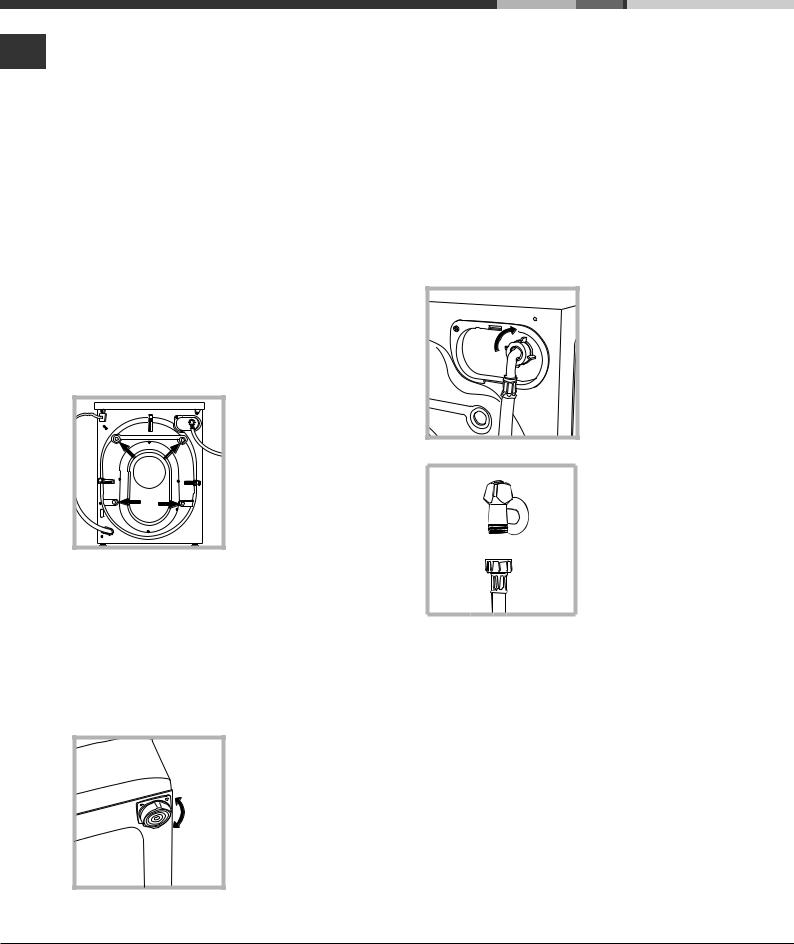
Installation
EN |
! This instruction manual should be kept in a |
|
safe place for future reference. If the Washer- |
||
|
||
|
dryer is sold, given away or moved, please |
|
|
ensure the manual is kept with the machine, |
|
|
so that the new owner may benefit from the |
|
|
advice contained within it. |
|
|
! Read these instructions carefully: they |
|
|
contain vital information relating to the safe |
|
|
installation and operation of the appliance. |
|
|
! Inside the pack containing this manual, you |
|
|
will also find the guarantee and all the details |
|
|
necessary for installation. |
|
|
Unpacking and levelling |
|
|
Unpacking |
|
|
1. Once you have removed all the packaging |
|
|
from the Washer-dryer, make sure it has not |
|
|
been damaged during transportation. |
|
|
If it has been damaged, contact the retailer |
|
|
and do not proceed any further with the |
|
|
installation process. |
|
|
2. Remove the 4 |
|
|
protective screws |
|
|
(used during |
|
|
transportation) and |
|
|
the corresponding |
|
|
spacer, located on |
|
|
the rear part of the |
|
|
appliance (see figure). |
3.Close off the holes using the plastic plugs supplied in the pack.
4.Keep all the parts in a safe place; they will be needed again if the Washer-dryer is moved to another location, to prevent the inside of the appliance being damaged.
! Packaging materials should not be used as toys for children.
Levelling
1. Place the Washerdryer on a flat sturdy floor, without resting it up against walls or
cabinets.
2. If the floor is uneven, the front feet of the machine may be adjusted until it reaches a horizontal position (the angle of
inclination must not exceed 2 degrees).
!If the appliance is levelled correctly, it will be more stable and much less likely to cause vibrations and noise while it is operating, particularly during the spin cycle.
!If it is placed on carpet or a rug, adjust the feet in such a way as to allow a sufficient ventilation space underneath the Washer-dryer.
Connecting the electricity and water supplies
Connecting the water inlet hose
! Before connecting the inlet hose to the water supply, run the water until it is perfectly clear.
1. Connect the inlet hose to the machine by screwing it onto the cold water inlet of the appliance, which is situated on the top right-hand side of the rear part of the appliance (see figure).
2. Connect the inlet hose by screwing it to a cold water tap using a 3/4 gas threaded connection (see figure).
3. Make sure that the hose is not folded over or bent.
! The water pressure at the tap must fall within the values indicated in the Technical data table
(see next page).
!If the inlet hose is not long enough, contact a specialised shop or an authorised technician.
!Never use second-hand or old inlet hoses; use the products supplied with the machine.
2
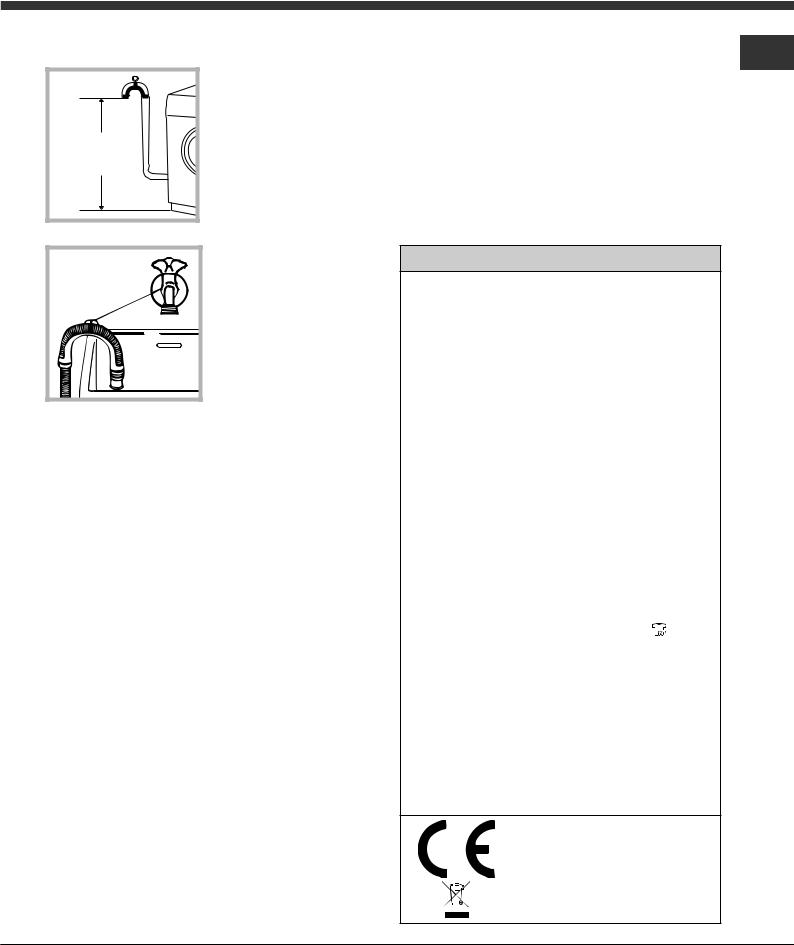
Connecting the drain hose
65 - 100 cm |
Connect the drain hose to drain duct piping or a wall drain located between 65 and 100 cm above the floor, making sure it is not bent at all.
Alternatively, rest the drain hose on the side of a washbasin or bathtub, fastening the duct supplied to the tap (see figure).
The free end of the hose should not be underwater.
! We advise against the use of hose extensions; if it is absolutely necessary, the extension must have the same diameter as the original hose and must not exceed 150 cm in length.
Electrical connections
Before plugging the appliance into the electricity socket, make sure that:
•the socket is earthed and complies with all applicable laws;
•the socket is able to withstand the maximum power load of the appliance as indicated in the Technical data table (see opposite);
•the power supply voltage falls within the values indicated in the Technical data table
(see opposite);
•the socket is compatible with the plug of the appliance. If this is not the case, have the socket or the plug replaced.
!The machine must not be installed outdoors, even in covered areas. It is extremely dangerous to leave the appliance exposed to rain, storms and other weather conditions.
!The mains socket must remain within easy reach after the Washer-dryer has been installed.
! Do not use extension cords or multiple sockets. |
EN |
|
!The cable should not be bent or compressed.
!The power supply cable and plug must only be replaced by authorised technicians.
Warning! The company shall not be held responsible in the event that these regulations are not respected.
Technical data
Model |
AQD970F 69 |
|
|
|
|
|
width 59.5 cm |
|
Dimensions |
height 85 cm |
|
|
depth 64.5 cm |
|
|
from 1 to 9 kg for the wash |
|
Capacity |
programme |
|
from 1 to 7 kg for the drying |
||
|
||
|
programme |
|
Electrical |
please refer to the technical |
|
data plate fixed to the ma- |
||
connections |
||
chine |
||
|
maximum pressure |
|
Water con- |
1 MPa (10 bar) |
|
minimum pressure |
||
nections |
0.05 MPa (0.5 bar) |
|
|
drum capacity 71 litres |
|
Spin speed |
up to 1600 rotations per |
|
minute |
||
|
Wash: programme ; tem- |
|
|
perature 60°C; using a load |
|
|
of 9 kg. |
|
Energy ra- |
Drying: the smaller load |
|
ted |
must be dried by selecting |
|
programmes |
the “EXTRA” dryness level. |
|
according to |
The load must consist of 2 |
|
regulation |
sheets, 1 pillowcase and |
|
EN 50229 |
1 hand towel; |
|
|
the remainder of the load |
|
|
must be dried by selecting |
|
|
the “EXTRA” dryness level. |
This appliance conforms to the following EC Directives:
-2004/108/EC (Electromagnetic Compatibility)
-2006/95/EC (Low Voltage)
- 2002/96/EC
3
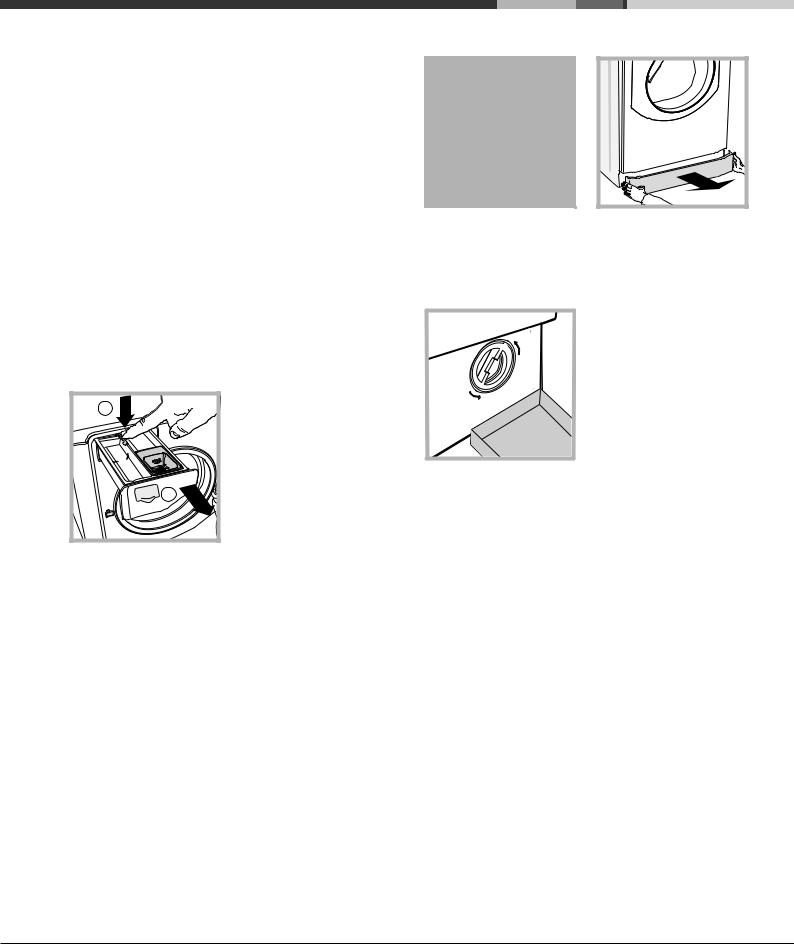
Care and maintenance
|
Cutting off the water and |
EN |
|
|
electricity supplies |
|
• Turn off the water tap after every wash cycle. |
|
This will limit wear on the hydraulic system in |
|
the machine and help to prevent leaks. |
|
• Unplug the appliance when cleaning it and |
|
during all maintenance work. |
Cleaning the machine
The outer parts and rubber components of the appliance can be cleaned using a soft cloth soaked in lukewarm soapy water. Do not use solvents or abrasives.
Cleaning the detergent dispenser drawer
1 |
1 |
2 |
2 |
To remove the drawer, press lever (1) and pull the drawer outwards (2)
(see figure).
Wash it under running water; this procedure should be repeated frequently.
Caring for your appliance drum
•Always leave the door ajar to prevent unpleasant odours from forming.
Cleaning the pump
The Washer-dryer is fitted with a selfcleaning pump which does not require any maintenance. Sometimes, small items (such as coins or buttons) may fall into the protective pre-chamber at the base of the pump.
! Make sure the wash cycle has finished and unplug the appliance.
To access the pre-chamber:
1. take off the cover panel on the front of the machine by first pressing it in the centre and then pushing downwards on both sides until you can remove it (see figures);
2. position a container so that it will collect the water which flows out (approximately 1.5 l)
(see figure);
3. unscrew the lid by rotating it in an anticlockwise direction (see figure);
4.clean the inside thoroughly;
5.screw the lid back on;
6.reposition the panel, making sure the hooks are securely in place before you push it onto the appliance.
Checking the water inlet hose
Check the inlet hose at least once a year. If there are any cracks, it should be replaced immediately: during the wash cycles, water pressure is very strong and a cracked hose could easily split open.
4

Precautions and tips
! The machine was designed and constructed in accordance with international safety regulations. The following information is provided for safety reasons and must therefore be read carefully.
General safety
•This appliance is not intended for use by persons (including children) with reduced physical, sensory or mental capabilities, or lack of experience and
knowledge, unless they have been given supervision or instruction concerning use of the appliance by a person responsible for their safety.
Children should be supervised to ensure that they do not play with the appliance.
–Do not dry unwashed items in the tumble dryer.
–Items that have been soiled with substances such
as cooking oil, acetone, alcohol, petrol, kerosene, spot removers, turpentine, waxes and wax removers should be washed in hot water with an extra amount of detergent before being dried in the tumble dryer.
–Items such as foam rubber (latex foam), shower caps, waterproof textiles, rubber backed articles and clothes or pillows fitted with foam rubber pads should not be dried in the tumble dryer.
–Fabric softeners, or similar products, should be used as specified by the fabric softener instructions.
–The final part of a tumble dryer cycle occurs without heat (cool down cycle) to ensure that the items are left at a temperature that ensures that the items will not be damaged.
WARNING: Never stop a tumble dryer before the end of the drying cycle unless all items are quickly removed and spread out so that the heat is dissipated.
•This appliance was designed for domestic use only.
•Do not touch the machine when barefoot or with wet or damp hands or feet.
•Do not pull on the power supply cable when unplugging the appliance from the electricity socket. Hold the plug and pull.
•Do not touch the drained water as it may reach extremely high temperatures.
•Never force the porthole door. This could damage the safety lock mechanism designed to prevent accidental opening.
•If the appliance breaks down, do not under any circumstances access the internal mechanisms in an attempt to repair it yourself.
•Always keep children well away from the appliance while it is operating.
•If it must be moved, proceed with the help of two or three people and handle it with the utmost care. Never try to do this alone, because the appliance is very heavy.
•Before loading laundry into the washer dryer, make sure the drum is empty.
•During the drying phase, the door tends to get quite hot.
•Do not use the appliance to dry clothes that have been washed with flammable solvents (e.g. trichlorethylene).
•Do not use the appliance to dry foam rubber or similar elastomers.
• Make sure that the water tap is turned on during |
EN |
|
the drying cycles. |
||
|
||
|
|
Disposal
•Disposing of the packaging materials: observe local regulations so that the packaging may be re-used.
•The European Directive 2002/96/EC relating to Waste Electrical and Electronic Equipment (WEEE) states that household appliances should not be disposed of using the normal solid urban waste cycle. Exhausted appliances should be collected separately in order to
optimise the cost of re-using and recycling the materials inside the machine, while preventing potential damage to the atmosphere and to public health. The crossed-out dustbin is marked on all products to remind the owner of their obligations regarding separated waste collection. For more information relating to the correct disposal of household appliances, owners should contact their local authorities or appliance dealer.
Opening the porthole door manually
In the event that it is not possible to open the porthole door due to a powercut, and if you wish to remove the laundry, proceed as follows:
1. remove the plug from the electrical socket.
2. make sure the water level inside the machine is lower than the door opening; if
it is not, remove excess water using the drain hose, collecting it in a bucket as indicated in the figure.
3. remove the cover panel on the lower front part of the washer dryer (see overleaf). 4. pull outwards using the tab as indicated in the figure, until the plastic tie-rod is freed from its stop position; pull downwards until you hear a “click”, which indicates that the door is now unlocked.
5. open the door; if this is still not possible repeat the procedure.
6. reposition the panel, making sure the hooks are securely in place before you push it onto the appliance.
5
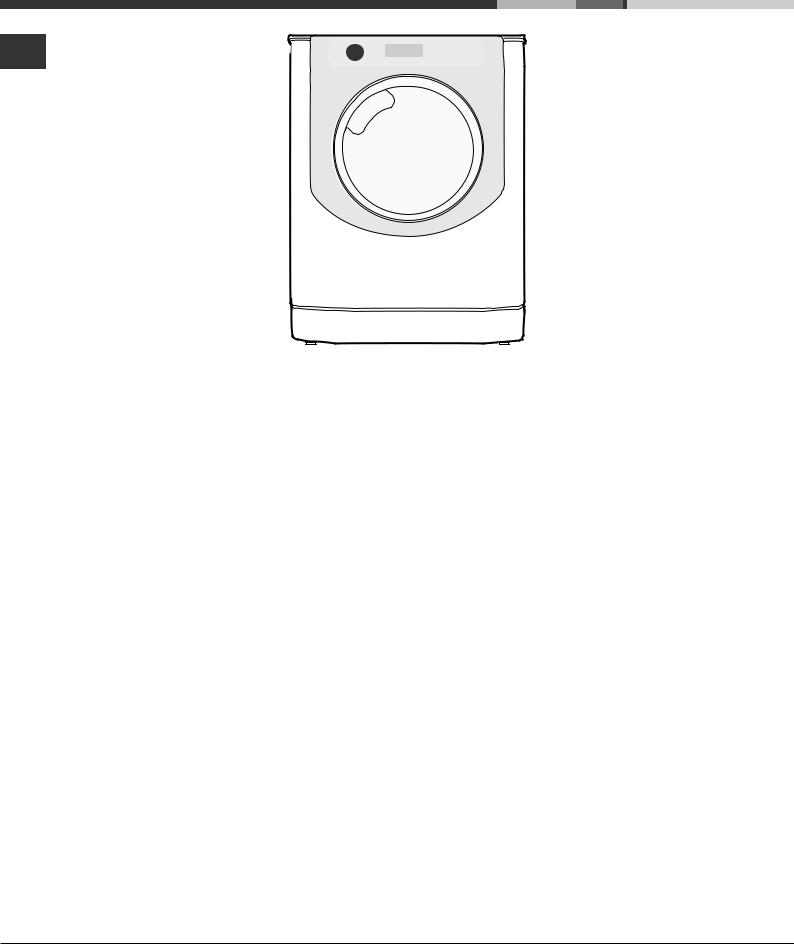
Description of the machine
EN |
|
CONTROL |
|
PORTHOLE DOOR |
PANEL |
|
|
PORTHOLE DOOR
HANDLE
KICK STRIP
ADJUSTABLE FEET
PORTHOLE DOOR
Always use the handle to open the porthole door (see figure).
DETERGENT DISPENSER DRAWER
The detergent dispenser drawer is located inside the machine and can be accessed by opening the door.
For more information on detergent measures, please refer to the chapter entitled
“Detergents and laundry”.
|
A |
|
1. pre-wash compartment: |
|
3 |
use powder detergent. |
|
|
|
! Before pouring in the |
|
|
|
|
|
|
|
1 |
detergent, make sure that |
B |
|
2 |
extra compartment 3 has |
|
been removed. |
||
|
|
|
|
|
|
|
2. main wash compartment: |
|
|
|
If liquid detergent is used, |
|
|
|
it is recommended that the |
|
|
|
removable plastic partition A |
(supplied) be used for proper dosage.If powder detergent is used, place the partition into slot B.
3. extra compartment: Bleach
! The use of extra compartment 3 excludes the prewash function.
 washing additives compartment: for fabric softener or liquid additives. We recommend that the maximum level indicated by the grille is not exceeded, and that concentrated fabric softeners are diluted.
washing additives compartment: for fabric softener or liquid additives. We recommend that the maximum level indicated by the grille is not exceeded, and that concentrated fabric softeners are diluted.
Standby mode
This wasdher-dryer, in compliance with new energy saving regulations, is fitted with an automatic standby system which is enabled after about 30 minutes if no activity is detected. Press the ON-OFF  button briefly and wait for the machine to start up again.
button briefly and wait for the machine to start up again.
Consumption in off-mode: 0,5 W Consumption in Left-on: 0,5 W
6

|
|
|
|
|
|
|
|
|
Control panel |
|
|
|
|
|
|
WASH |
|
|
|
|
ECO |
|
EN |
|||
|
|
|
|
|
||||
|
|
|
|
indicator light |
|
CYCLE |
|
|
|
|
|
|
|
||||
|
|
|
|
|
|
START/ |
PHASE |
|
|
|
|
|
|
|
|||
|
|
|
|
|
|
icons |
||
|
OPTION buttons |
OPTION buttons |
|
PAUSE |
||||
WASH CYCLE |
|
|
|
|||||
with indicator lights |
with indicator lights |
|
button with |
|
|
|||
|
|
|
|
|||||
SELECTOR knob |
|
|
|
|
|
indicator light |
|
|
|
|
|
|
|
|
|
||
|
|
|
|
|
|
|
|
|
|
|
|
|
|
|
|
|
|
|
|
|
|
|
|
|
|
|
DISPLAY
Button with ON/OFF |
TEMPERATURE button |
|
|
|
DELAYED |
|
|
CONTROL PANEL |
|
|
|
|
|
||||
indicator light |
|
|
|
START |
LOCK |
|
LOCK button with |
|
|
|
|
||||||
|
|
|
|
|
||||
|
DRYING button |
|
button |
indicator light |
indicator light |
|||
|
|
|
|
|
|
|||
Button with  ON/OFF indicator light: press this briefly to switch the machine on or off. The green indicator light indicates that the machine is switched on. To switch off the wasdher-dryer during the wash cycle, press and hold the button for approximately 3 seconds; if the button is pressed briefly or accidentally the machine will not switch off. If the machine is switched off during a wash cycle, this wash cycle will be cancelled.
ON/OFF indicator light: press this briefly to switch the machine on or off. The green indicator light indicates that the machine is switched on. To switch off the wasdher-dryer during the wash cycle, press and hold the button for approximately 3 seconds; if the button is pressed briefly or accidentally the machine will not switch off. If the machine is switched off during a wash cycle, this wash cycle will be cancelled.
WASH CYCLE SELECTOR knob: may be turned in either direction. To select the most suitable wash cycle, please refer to the “Table of wash cycles”.
The knob will not move during the wash cycle.
TEMPERATURE 
 button: press to modify or exclude the temperature setting; the value selected will appear on the display above (see “How to run a wash cycle or a drying cycle”).
button: press to modify or exclude the temperature setting; the value selected will appear on the display above (see “How to run a wash cycle or a drying cycle”).
DRYING button  : press to decrease or exclude drying; the selected drying level or time will appear on the display
: press to decrease or exclude drying; the selected drying level or time will appear on the display
(see “How to run a wash cycle or a drying cycle”).
DELAYED START  button: press to set a delayed start for the selected wash cycle; the set delay time will appear on the display above (see “How to run a wash cycle or a drying cycle”).
button: press to set a delayed start for the selected wash cycle; the set delay time will appear on the display above (see “How to run a wash cycle or a drying cycle”).
OPTION buttons with indicator lights: press to select the available options. The indicator light corresponding to the selected option will remain lit (see “How to run a wash cycle or a drying cycle”).
WASH CYCLE PHASE icons: these illuminate to indicate
the progress of the wash cycle (Wash |
– Rinse |
– |
Spin/Drain – Drying ). The text |
lights up when the |
|
cycle is complete. |
|
|
START/PAUSE button with indicator light: when the green indicator light flashes slowly, press the button to start a wash cycle. Once the cycle has begun the indicator light will remain lit in a fixed manner. To pause the wash cycle, press the button again; the indicator light will flash in an orange colour. If the “LOCK”  indicator light is switched off, the door may be opened. To start the wash cycle from the point at which it was interrupted, press the button again.
indicator light is switched off, the door may be opened. To start the wash cycle from the point at which it was interrupted, press the button again.
LOCK  indicator light: indicates that the porthole door is locked. To open the door, pause the wash cycle (see “How to run a wash cycle or a drying cycle”).
indicator light: indicates that the porthole door is locked. To open the door, pause the wash cycle (see “How to run a wash cycle or a drying cycle”).
CONTROL PANEL LOCK  button with indicator light: to activate or deactivate the control panel lock, press and hold the button for approximately 2 seconds. when the indicator light is illuminated, the control panel is locked (apart from the ON/OFF button). This means it is possible to prevent wash cycles from being modified accidentally, especially where there are children in the home.
button with indicator light: to activate or deactivate the control panel lock, press and hold the button for approximately 2 seconds. when the indicator light is illuminated, the control panel is locked (apart from the ON/OFF button). This means it is possible to prevent wash cycles from being modified accidentally, especially where there are children in the home.
ECO indicator light: the 

 icon lights up when, after altering the washing parameters, an energy saving of at least 10% is made. Furthermore, before the machine enters “Standby” mode, the icon will light up for a few
icon lights up when, after altering the washing parameters, an energy saving of at least 10% is made. Furthermore, before the machine enters “Standby” mode, the icon will light up for a few
seconds; when the machine is switched off the estimated energy saving will be around the 80% mark.
7

How to run a wash cycle or a drying cycle
WARNING: before you use the wasdher-dryer for the first EN time, run a wash cycle with detergent and no laundry, using
the 90° cottons cycle without pre-wash.
1.SWITCH THE MACHINE ON. Press the  button. All the indicator lights will illuminate for 1 second; the
button. All the indicator lights will illuminate for 1 second; the
indicator light corresponding to the  button will then remain lit in a fixed manner and the START/PAUSE indicator light will flash slowly.
button will then remain lit in a fixed manner and the START/PAUSE indicator light will flash slowly.
2.LOAD THE LAUNDRY. Open the porthole door. Load the laundry, making sure you do not exceed the maximum load value indicated in the table of wash cycles on the following page.
3.MEASURE OUT THE DETERGENT. Pull out the detergent dispenser drawer and pour the detergent into the relevant compartments as described in “Description of the machine”.
4.CLOSE THE PORTHOLE DOOR.
5.SELECT THE PROGRAMME. Turn the WASH CYCLE SELECTOR KNOB right or left, until you have selected the desired wash cycle.
6.CUSTOMISE THE WASH CYCLE. Use the relevant buttons on the control panel:
Modify the temperature.
The machine automatically displays the maximum temperature values set for the selected cycle, or the most recently-used settings if they are compatible with the selected cycle. The temperature can be decreased by pressing the 
 button, until the cold wash (
button, until the cold wash (

 ) setting is reached. If this button is pressed again, the maximum values are restored.
) setting is reached. If this button is pressed again, the maximum values are restored.
! Exception: if the  programme is selected, the temperature can be increased up to a value of 90°C.
programme is selected, the temperature can be increased up to a value of 90°C.
Setting the drying cycle.
The first time the button  is pressed, the machine will automatically select the maximum drying cycle which is compatible with the selected wash cycle. Subsequent presses will decrease the drying level and then the drying time, until the cycle is excluded completely (
is pressed, the machine will automatically select the maximum drying cycle which is compatible with the selected wash cycle. Subsequent presses will decrease the drying level and then the drying time, until the cycle is excluded completely (
 ). If this button is pressed again, the maximum values are restored.
). If this button is pressed again, the maximum values are restored.
Drying may be set as follows:
A - Based on a set time period: between 20 and 180 minutes. B- Based on the desired laundry dryness level:
Iron “L1”: suitable for clothes which will need ironing afterwards. the remaining dampness softens creases, making them easier to remove.
Hanger “L2”: ideal for clothes which do not need to be dried fully.
Cupboard “L3”: suitable for laundry which can be put back in a cupboard without being ironed.
Extra “L4”: suitable for garments which need to be dried completely, such as sponges and bathrobes.
If your laundry load to be washed and dried is much greater than the maximum stated load, perform the wash cycle, and when the cycle is complete, divide the garments into groups and put some of them back in the drum. At this point, follow the instructions provided for a “Drying only” cycle. Repeat this procedure for the remainder of the load.
A cooling-down period is always added to the end of each drying cycle.
Drying only
Use the cycle selector knob to select a drying cycle ( -
- -
- ) in accordance with the type of fabric. The desired drying level or time may also be set using the DRYING button
) in accordance with the type of fabric. The desired drying level or time may also be set using the DRYING button  .
.
Set a delayed start.
Press the button until you have reached the desired delay time. During the setting process, the delay time is shown on the display and the  symbol flashes. After selecting a delayed start time, the fixed
symbol flashes. After selecting a delayed start time, the fixed  symbol and the cycle duration will appear on the display. Press the button once to display the selected delay time. To remove the delayed start option, press the button until the display shows the text OFF; the
symbol and the cycle duration will appear on the display. Press the button once to display the selected delay time. To remove the delayed start option, press the button until the display shows the text OFF; the 

 symbol will disappear.
symbol will disappear.
! Once the START/PAUSE button has been pressed, the time delay may only be decreased.
Modify the cycle settings.
Press the OPTION buttons to customise the wash cycle in accordance with your own requirements.
•Press the button to activate the option; the corresponding indicator light will switch on.
•Press the button again to disable the option; the indicator light will switch off.
! If the selected option is not compatible with the selected wash cycle, this incompatibility will be signalled by the flashing of the indicator light and a sound alert
(3 beeps); the option will not be activated.
! If the selected option is not compatible with another option that has been selected previously, the indicator light corresponding to the first option selected will flash and only the second option will be activated; the indicator light corresponding to the button will remain lit in a constant manner.
7.START THE PROGRAMME. Press the START/PAUSE button. The corresponding indicator light remains lit in a
fixed manner and the porthole door locks (the  LOCK indicator light illuminates). The icons corresponding to the wash cycle phases will light up during the cycle to indicate which phase is currently in progress. To change a wash cycle once it has already started, pause the wasdher-dryer by pressing the START/PAUSE button; then select the desired cycle and press the START/PAUSE button again. To open the door during a wash cycle, press the START/
LOCK indicator light illuminates). The icons corresponding to the wash cycle phases will light up during the cycle to indicate which phase is currently in progress. To change a wash cycle once it has already started, pause the wasdher-dryer by pressing the START/PAUSE button; then select the desired cycle and press the START/PAUSE button again. To open the door during a wash cycle, press the START/
PAUSE button; if the LOCK  indicator light is switched off you may open the door. Press the START/PAUSE button again to restart the wash cycle from the point at which it was interrupted.
indicator light is switched off you may open the door. Press the START/PAUSE button again to restart the wash cycle from the point at which it was interrupted.
8.THE END OF THE WASH CYCLE. This is indicated by the illuminated text END. The porthole door may be opened immediately. If the START/PAUSE indicator light is flashing, press the button to end the cycle. Open the door, unload the laundry and switch off the machine.
! If you wish to cancel a cycle which has already begun, press and hold the  button until the cycle stops and the machine switches off.
button until the cycle stops and the machine switches off.
8
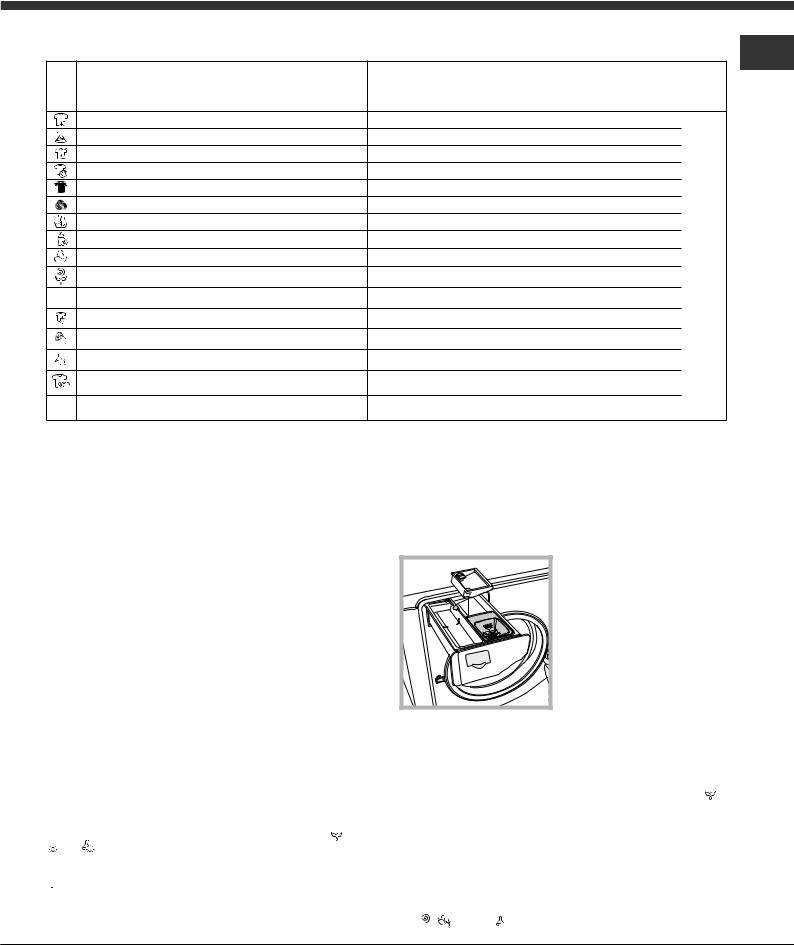
Wash cycles and options
Table of wash cycles |
EN |
|
Icon Description of the wash cycle
Cotton Coloureds (2): lightly soiled whites and delicate colours.
Synthetics Resistant
Whites
Coloureds
Darks
Wool Platinum Care: for wool, cashmere, etc.
Ultradelicates
Anti Allergy
Rinse
Spin and Pump out
 Wash&Dry
Wash&Dry
Drying Cottons
Drying Wool
Drying Synthetics
Cotton Hygiene Prewash
(Add detergent to the relevant compartment).
 Cotton Whites (1): heavily soiled whites and resistant colours.
Cotton Whites (1): heavily soiled whites and resistant colours.
Max. temp. |
Max. |
|
Detergent and additives |
Max. |
Cycle |
||||
speed |
Drying |
Pre- |
|
|
Fabric |
load |
|||
(°C) |
(rpm) |
|
wash |
Wash |
Bleach |
softener |
(kg) |
duration |
|
40° |
1600 |
|
- |
|
|
|
9 |
(*) |
|
The |
|||||||||
60° |
800 |
|
- |
|
|
|
5 |
||
60° |
1600 |
|
- |
|
- |
|
6 |
of duration |
|
40° |
1600 |
|
- |
|
|
|
6 |
||
30° |
800 |
|
- |
|
- |
|
6 |
||
40° |
800 |
|
- |
|
- |
|
2,5 |
the |
|
|
|
|
|
|
|
|
|
||
30° |
0 |
|
- |
|
- |
|
1 |
wash |
|
60° |
1600 |
|
- |
|
- |
|
6 |
||
cycles |
|||||||||
- |
1600 |
|
- |
- |
|
|
9 |
||
- |
1600 |
|
- |
- |
- |
- |
9 |
||
can |
|||||||||
|
|
|
|
|
|
|
|
||
30° |
1600 |
|
- |
|
- |
|
1 |
be |
|
|
|
|
|
|
|
|
|
||
- |
- |
|
- |
- |
- |
- |
7 |
on checked |
|
- |
- |
|
- |
- |
- |
- |
2,5 |
||
- |
- |
|
- |
- |
- |
- |
5 |
||
the |
|||||||||
90° |
1600 |
|
|
|
- |
|
9 |
||
.display |
|||||||||
60° |
1600 |
|
- |
|
|
|
9 |
||
(Max. 90°C) |
|||||||||
|
|
|
|
|
|
|
|||
|
|
|
|
|
|
|
|
||
The length of cycle shown on the display or in this booklet is an estimation only and is calculated assuming standard working conditions. The actual duration can vary according to factors such as water temperature and pressure, the amount of detergent used, the amount and type of load inserted, load balancing and any wash options selected.
(*) Note: 10 minutes after the START, the machine will recalculate the time remaining until the end of the wash cycle on the basis of the load inside it; this value will then be shown on the display.
For all Test Institutes:
1)Test wash cycle in compliance with regulation EN 50229: set wash cycle  with a temperature of 60°C.
with a temperature of 60°C.
2)Long wash cycle for cottons: set wash cycle  with a temperature of 40°C.
with a temperature of 40°C.
Wash options
 Extra rinse
Extra rinse
By selecting this option, the efficiency of the rinse is increased and optimal residual detergent removal is guaranteed. It is particularly useful for skin which is sensitive to detergents. We recommend this option is used with a full load of washing, or when a large amount of detergent is required.
! It cannot be used in conjunction with  ,
,  ,
,  ,
,  ,
,  ,
,  ,
,  ,
,  .
.
 Easy Iron
Easy Iron
By selecting this option, the wash and spin cycles will be modified in order to reduce the formation of creases.
At the end of the cycle the wasdher-dryer drum will rotate slowly; the “Easy Iron” and START/PAUSE indicator lights will flash. To end the cycle press the START/PAUSE button or the “Easy Iron” button.
! It cannot be used in conjunction with  ,
,  ,
,  ,
,  ,
,  ,
,  ,
,
 ,
,  , .
, .
Note: If you also want to run the drying cycle, this option is enabled only if combined with level “Iron”.
 Super Wash
Super Wash
This option offers a high-performance wash due to the greater quantity of water used in the initial phase
|
of the cycle, and due to |
|
3 |
the increased wash cycle |
|
duration, is particularly useful |
||
|
||
1 |
for the removal of stubborn |
|
2 |
stains. It can be used with or |
|
without bleach. |
||
|
If you desire bleaching, insert |
|
|
the extra tray compartment |
|
|
(3) into compartment 1. |
|
|
When pouring in the bleach, |
|
|
be careful not to exceed the |
“max” level marked on the central pivot (see figure). To bleach laundry without carrying out a full wash cycle, pour the bleach into the extra compartment 3, select the “Rinse” cycle”  and activate the “Super Wash” option
and activate the “Super Wash” option 

 . ! It cannot be used in conjunction with
. ! It cannot be used in conjunction with  ,
,  ,
,  ,
,  ,
,  ,
,  ,
,  ,
,  ,
,  ,
,  ,
,  .
.
 Time Saver
Time Saver
If you select this option, the wash cycle duration will be reduced by up to 50%, depending on the selected cycle, thereby guaranteeing simultaneous water and energy saving. Use this cycle for lightly soiled garments.
! It cannot be used in conjunction with  ,
,  ,
,  ,
,  ,
,  ,
,
 ,
,  , ,
, ,  ,
,  ,
,  .
.
9

Detergents and laundry
EN |
Detergent |
|
The type and quantity of detergent required depend on |
|
the type of fabric you are washing (cotton, wool, silk, etc.), |
|
as well as its colour, the washing temperature, the level of |
|
soiling and the hardness of the water in the area. |
|
Measuring out the detergent carefully will avoid wastage |
|
and help to protect the environment: although they are |
|
biodegradable, detergents still contain ingredients which |
|
alter the balance of nature. |
|
We recommend the following: |
|
• use powder detergents for white cotton garments and |
|
pre-washing. |
|
• use liquid detergents for delicate cotton garments and |
|
for all low-temperature wash cycles. |
|
• use gentle liquid detergents for wool and silk garments. |
|
The detergent should be poured into the relevant |
|
compartment - or the dispenser placed directly inside the |
|
drum - before the wash cycle begins. In the latter case, it will |
|
not be possible to select the Cottons with pre-wash cycle. |
|
! Do not use hand washing detergents because these |
|
create too much foam. |
Preparing the laundry
•Shake out the garments before loading them into the machine.
•Divide the laundry according fabric type (symbol on the washing instruction label) and colour, making sure you separate the coloured garments from the white ones;
•Empty all pockets and check the buttons;
•Do not exceed the values listed in the “Table of wash cycles”, which refer to the weight of the laundry when dry.
How much does your laundry weigh?
1 sheet |
400-500 g |
1 pillowcase |
150-200 g |
1 tablecloth |
400-500 g |
1 bathrobe |
900-1200 g |
1 towel |
150-250 g |
1 pair of jeans |
400-500 g |
1 shirt |
150-200 g |
Washing recommendations
Whites: use this cycle  to wash white clothes. The programme is designed to maintain the brightness of white clothes over time.
to wash white clothes. The programme is designed to maintain the brightness of white clothes over time.
If the drying function is selected, a drying cycle automatically activates at the end of the wash cycle that resembles open-air drying, with the added advantages of preserving garments from yellowing due to sunlight exposure and preventing loss of whiteness caused by the
possible presence of dust in the air. Drying cycles can only be selected on a level basis.
Coloureds: use this cycle  to wash bright coloured clothes. The programme is designed to maintain bright colours over time.
to wash bright coloured clothes. The programme is designed to maintain bright colours over time.
Darks: Use cycle  to wash dark-coloured garments. This programme is designed to maintain dark colours over time. We recommend using a liquid detergent for the best results when washing dark-coloured garments.
to wash dark-coloured garments. This programme is designed to maintain dark colours over time. We recommend using a liquid detergent for the best results when washing dark-coloured garments.
When you select the drying function, at the end of the washing cycle the machine will automatically perform a
delicate drying cycle that preserves the colours of the garments. The display will show the level “L2”.
Max. load: 3 kg.
Wool: the wool wash cycle on this Hotpoint-Ariston machine has been tested and approved by The Woolmark Company for washing wool garments labelled as hand washable provided that the garments are washed according to the instructions on the garment label and those issued by the manufacturer of this washing machine. Hotpoint-Ariston is the first washing machine brand to be approved by The Woolmark Company for Apparel CarePlatinum for its washing performance and consumption of energy and water. (M1135) 


In UK, Eire, Hong Kong and India the Woolmark trade mark is a Certification trade mark.
Ultradelicates: use programme  to wash very delicate garments having strasses or sequins.
to wash very delicate garments having strasses or sequins.
We recommend turning the garments inside out before washing and placing small items into the special bag for washing delicates. Use liquid detergent on delicate garments for best results.
To wash Silk garments and Curtains select cycle  and then option
and then option  (in this case it will also be possible to enable the “Extra Rinse” option); the machine will end the cycle while the laundry is soaking and the
(in this case it will also be possible to enable the “Extra Rinse” option); the machine will end the cycle while the laundry is soaking and the  indicator light will flash. To drain the water so that the laundry may be removed, press the START/PAUSE button or the
indicator light will flash. To drain the water so that the laundry may be removed, press the START/PAUSE button or the  button.
button.
When selecting an exclusively time-based drying function, a drying cycle is performed at the end of the wash cycle that is particularly delicate, thanks to light handling and appropriate temperature control of the water jet.
The recommended durations are:
1 kg of synthetic garments --> 160 min
1 kg of synthetic and cotton garments --> 180 min 1 kg of cotton garments --> 180 min
The degree of dryness depends on the load and fabric composition.
Anti Allergy: use programme  to remove major allergens such as pollen, mites, cat’s and dog’s hair. Wash&Dry: select programme for washing and drying lightly soiled garments (Cotton and Synthetic) in a short time. This cycle may be used to wash and dry a laundry load of up to 1 kg in just 45 minutes. To achieve optimum results, use liquid detergent and pre-treat cuffs, collars and stains. Stubborn stains: it is wise to treat stubborn stains with solid soap before washing, and to use the Cottons with pre-wash cycle.
to remove major allergens such as pollen, mites, cat’s and dog’s hair. Wash&Dry: select programme for washing and drying lightly soiled garments (Cotton and Synthetic) in a short time. This cycle may be used to wash and dry a laundry load of up to 1 kg in just 45 minutes. To achieve optimum results, use liquid detergent and pre-treat cuffs, collars and stains. Stubborn stains: it is wise to treat stubborn stains with solid soap before washing, and to use the Cottons with pre-wash cycle.
Load balancing system
Before every spin cycle, to avoid excessive vibrations before every spin and to distribute the load in a uniform manner, the drum rotates continuously at a speed which is slightly greater than the washing rotation speed. If, after several attempts, the load is not balanced correctly, the machine spins at a reduced spin speed. If the load is excessively unbalanced, the Washer-dryer performs the distribution process instead of spinning. To encourage improved load distribution and balance, we recommend small and large garments are mixed in the load.
10

Trouble shooting
Your wasdher-dryer could occasionally fail to work. Before contacting the Technical Assistance Centre (see “Assistance”), |
EN |
make sure that the problem cannot be solved easily using the following list. |
Problem:
The Washer-dryer does not switch on.
The wash cycle does not start.
The Washer-dryer does not fill with water.
The Washer-dryer door remains locked.
Possible causes / Solutions:
•The appliance is not plugged into the socket fully, or not enough to make contact.
•There is no power in the house.
•The door is not closed properly.
•The START/PAUSE button has not been pressed.
•The water tap has not been opened.
•A delayed start has been set.
•The water inlet hose is not connected to the tap.
•The hose is bent.
•The water tap has not been opened.
•There is no water supply in the house.
•The pressure is too low.
•The START/PAUSE button has not been pressed.
•If you have selected the  function, at the end of the cycle the Washer-dryer drum will rotate slowly; to end the cycle press the START/PAUSE button or the
function, at the end of the cycle the Washer-dryer drum will rotate slowly; to end the cycle press the START/PAUSE button or the  button.
button.
The machine continuously fills with |
• |
The drain hose is not fitted at a height between 65 and 100 cm from the floor |
|
water and drains. |
|
(see “Installation”). |
|
|
• The free end of the hose is under water (see “Installation”). |
||
|
• If the dwelling is on one of the upper floors of a building, there may be |
||
|
|
problems relating to water drainage, causing the Washer-dryer to fill with water |
|
|
|
and drain continuously. Special anti-draining valves are available in shops and |
|
|
|
help to prevent this inconvenience. |
|
|
• The wall drainage system is not fitted with a breather pipe. |
||
The Washer-dryer does not drain or |
• |
The wash cycle does not include draining: Some wash cycles require the drain |
|
spin. |
|
phase to be started manually (see “Wash cycles and options”). |
|
|
• |
The |
option is enabled: to complete the wash cycle, press the START/ |
PAUSE button (“Wash cycles and options”).
• The drain hose is bent (see Installation).
• The drainage duct is clogged.
The machine vibrates a lot during the spin cycle.
•The drum was not unlocked correctly during installation (see “Installation”).
•The machine is not level (see “Installation” ).
•The machine is trapped between cabinets and walls (see “Installation”).
•The load is unbalanced (see “Detergents and laundry”).
The Washer-dryer leaks.
•The water inlet hose is not screwed on properly (see “Installation”).
•The detergent dispenser is blocked (to clean it, see “Care and maintenance”).
•The drain hose is not fixed in place properly (see “Installation”).
The icons corresponding to the “Phase in progress” flash rapidly at the same time as the ON/OFF indicator light.
There is too much foam.
•Switch off the machine and unplug it, wait for approximately 1 minute and then switch it back on again. If the problem persists, contact the Technical Assistance Service.
•The detergent is not suitable for machine washing (it should display the text “for Washing machine” or “hand and machine wash”, or the like).
•Too much detergent was used.
The Washer-dryer door remains • Perform the manual unlocking procedure (see “Precautions and tips”). locked.
The washer-dryer does not dry. • The appliance is not plugged into the socket, or not enough to make contact.
•There has been a power failure.
•The appliance door is not shut properly.
•A DELAY TIMER has been set.
•DRYING is in the (

 ) position.
) position.
11

Assistance
|
|
|
|
|
|
|
|
Before calling for Assistance: |
|
||||
EN |
|
|||||
• Check whether you can solve the problem by yourself (see “Trouble shooting”); |
|
|||||
|
|
|||||
|
• Restart the wash cycle to check whether the problem has been solved; |
|
||||
|
|
|||||
|
• If it has not, contact the Authorised Technical Assistance Service. |
|
||||
|
! If the wasdher-dryer has been installed or used incorrectly, you will have to pay for the call-out service. |
|
||||
|
! Always request the assistance of authorised technicians. |
|
||||
Please have the following information to hand:
•the type of problem;
•the appliance model (Mod.);
•the serial number (S/N).
The above information can be found on the data plate located on the appliance itself.
! Note: to exit “Demo mode”, switch machine off, then press and hold the two “START/PAUSE” 
 and “ON/OFF”
and “ON/OFF”  buttons simultaneously for 3 seconds.
buttons simultaneously for 3 seconds.
12

Instrucciones para la instalación y el uso
LAVASECADORA
|
|
|
! |
|
|
Este símbolo te recuerda que debes leer este manual de |
ES |
|
instrucciones. |
|
|
|
||
ES |
|
Sumario |
|
|
|
Español |
Instalación, 26-27 |
|
|
|
|
|
|
Desembalaje y nivelación |
|
|
Conexiones hidráulicas y eléctricas |
|
|
Datos técnicos |
|
|
Mantenimiento y cuidados, 28 |
|
|
Interrumpir el agua y la corriente eléctrica |
|
|
Limpiar la máquina |
|
|
Limpiar el contenedor de detergentes |
|
|
Cuidar el cesto |
|
|
Limpiar la bomba |
|
|
Controlar el tubo de alimentación de agua |
AQUALTIS
AQD970F 69
Precauciones y consejos, 29
Seguridad general
Eliminación
Apertura manual de la puerta
Descripción de la máquina, 30-31
Panel de control
Cómo efectuar un ciclo de lavado o de secado o de secado, 32
Programas y opciones, 33
Tabla de Programas
Opciones de lavado
Detergentes y ropa, 34
Detergente
Preparar la ropa
Consejos sobre el lavado
Sistema de equilibrado de la carga
Anomalías y soluciones, 35
Asistencia, 36
25
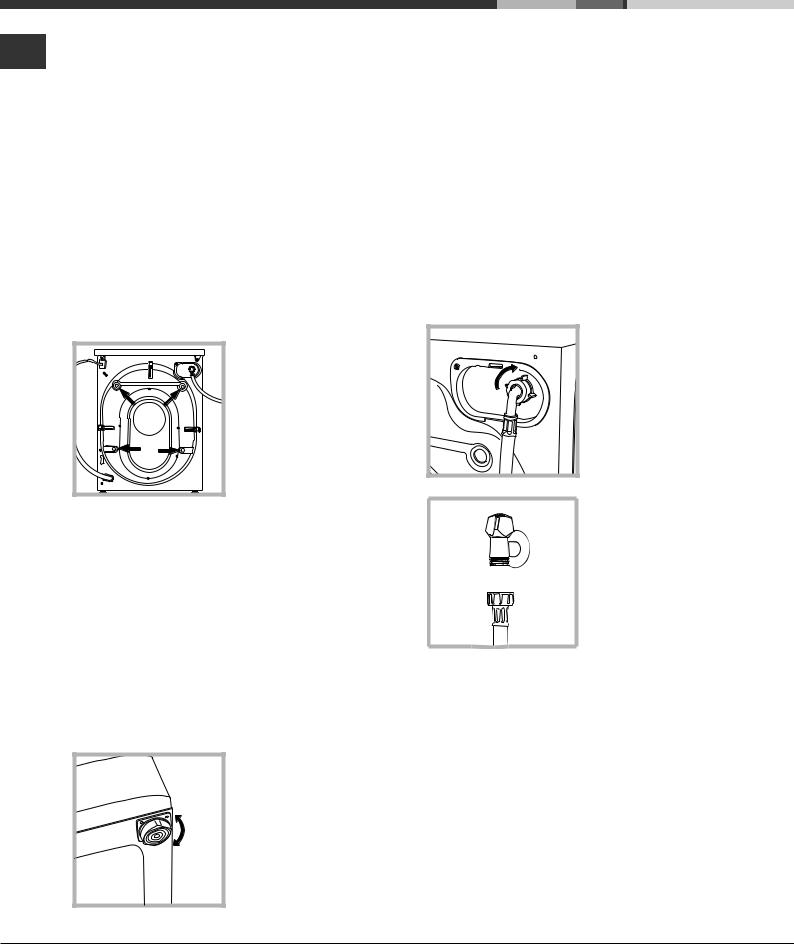
Instalación
! Es importante conservar este manual para ES poder consultarlo en cualquier momento. En el caso de venta, cesión o traslado, controle que
permanezca junto con la lavasecadora.
!Lea atentamente las instrucciones: ellas contienen importante información sobre la instalación, el uso y la seguridad.
!En el sobre que contiene este manual encontrará, además de la garantía, piezas que servirán para la instalación.
Desembalaje y nivelación
Desembalaje
1. Una vez desembalada la lavasecadora, controle que no haya sufrido daños durante el traslado. Si estuviera dañada no la conecte y llame al revendedor.
2. Quite los 4 tornillos de protección para
el transporte y el
correspondiente distanciador, ubicados en la parte posterior (ver la figura).
3.Cierre los orificios con los tapones de plástico contenidos en el sobre.
4.Conserve todas las piezas porque si la lavasecadora tuviera que ser trasladada nuevamente, se deberían volver a colocar para evitar daños internos.
! Los embalajes no son juguetes para los niños.
Nivelación
1. Instale la lavasecadora sobre un piso plano y rígido, sin apoyarla en las paredes ni en los muebles.
2. Compense las irregularidades desenroscando o enroscando las patas hasta que la máquina quede en posición horizontal (no debe estar inclinada más de 2 grados).
!Una cuidadosa nivelación brinda estabilidad y evita vibraciones y ruidos, sobre todo durante el centrifugado.
!Cuando se instala sobre moquetas o alfombras, regule las patas para que, debajo de la lavasecadora, quede un espacio suficiente para la ventilación.
Conexiones hidráulicas y eléctricas
Conexión del tubo de alimentación de agua
! Antes de conectar el tubo de alimentación a la red hídrica, haga correr agua hasta que sea
límpida. |
1. Conecte el tubo de alimentación a la máquina enroscándolo en la toma de agua correspondiente
ubicada en la parte posterior derecha (arriba) (ver la figura).
2. Conecte el tubo de alimentación enroscándolo a un grifo de agua fría con la boca roscada de 3/4 gas (ver la figura).
3. Controle que en el tubo no hayan pliegues ni estrangulaciones.
! La presión de agua del grifo debe estar comprendida dentro de los valores contenidos en la tabla de Datos técnicos (ver la página correspondiente).
!Si la longitud del tubo de alimentación no es la suficiente, diríjase a un negocio especializado o a un técnico autorizado.
!No utilice nunca tubos de carga usados o viejos, utilice siempre los suministrados con la máquina.
26
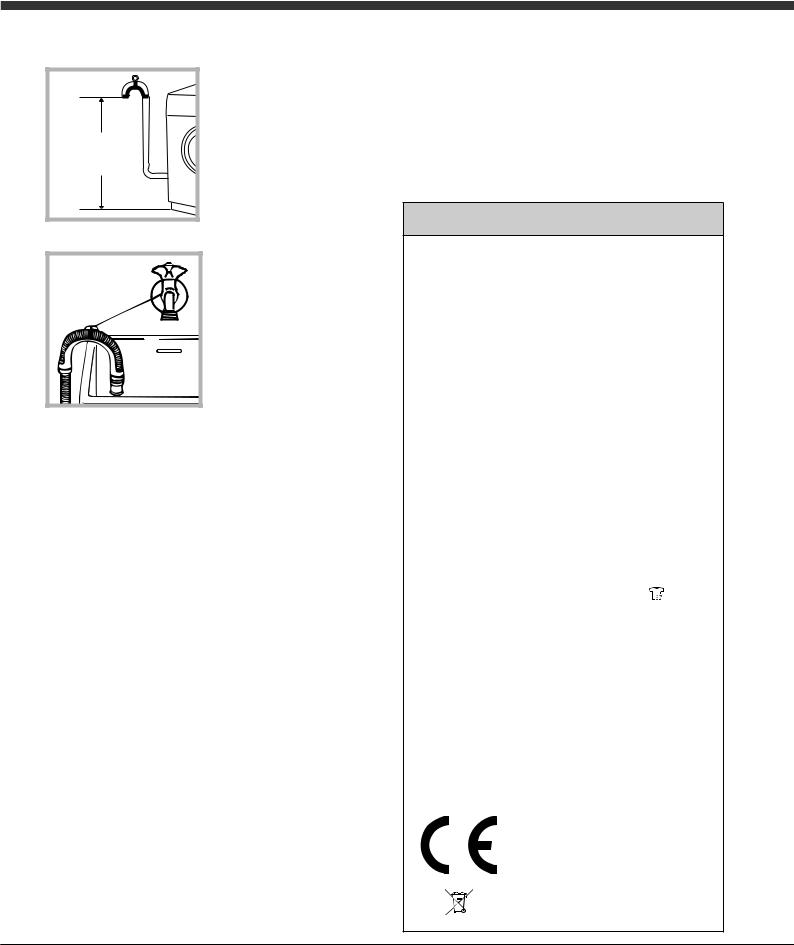
Conexión del tubo de descarga
65 - 100 cm |
Conecte el tubo de descarga a una tubería de descarga o a una descarga
de pared ubicadas a una distancia del piso comprendida entre 65 y 100 cm., evitando siempre plegarlo.
Una alternativa es apoyar el tubo de
descarga en el borde de un lavamanos
o de una bañera,
uniendo la guía
suministrada con el
aparato, al grifo (ver
la figura).
El extremo libre del tubo de descarga no
debe permanecer sumergido en el agua.
! No se aconseja utilizar tubos de prolongación, si fuera indispensable hacerlo, la prolongación debe tener el mismo diámetro del tubo original y no superar los 150 cm.
Conexión eléctrica
Antes de enchufar el aparato, verifique que:
•la toma tenga la conexión a tierra y haya sido hecha según las normas legales;
•la toma sea capaz de soportar la carga máxima de potencia de la máquina indicada en la tabla de Datos técnicos (ver al costado);
•la tensión de alimentación esté comprendida dentro de los valores indicados en la tabla de Datos técnicos (ver al costado);
•la toma sea compatible con el enchufe de la máquina. Si no es así, sustituya la toma o el enchufe.
!La máquina no debe ser instalada al aire libre, ni siquiera si el lugar está protegido, ya que es muy peligroso dejarla expuesta a la lluvia o a las tormentas.
!Una vez instalada la máquina, la toma de corriente debe ser fácilmente accesible.
!No utilice prolongaciones ni conexiones múltiples.
!El cable no debe estar plegado ni sufrir compresiones.
! El cable de alimentación y el enchufe deben |
|
|
ES |
||
ser sustituidos sólo por técnicos autorizados. |
||
|
||
¡Atención! La empresa fabricante declina toda |
|
|
responsabilidad en caso de que estas normas |
|
|
no sean respetadas. |
|
Datos técnicos
Modelo |
AQD970F 69 |
|||
|
|
|
|
|
Dimensio- |
ancho 59.5 cm |
|||
altura 85 cm |
||||
nes |
||||
profundidad 64,5 cm |
||||
|
|
|
||
Capacidad |
de 1 a 9 kg para el lavado |
|||
de 1 a 7 kg para el secado |
||||
Conexiones |
ver la placa de característi- |
|||
cas técnicas aplicada en la |
||||
eléctricas |
máquina |
|||
|
|
|
||
|
|
|
presión máxima 1 MPa |
|
Conexiones |
(10 bar) |
|||
presión mínima 0,05 MPa |
||||
hídricas |
(0,5 bar) |
|||
|
|
|
capacidad del cesto 71 litros |
|
Velocidad |
|
|||
de |
máxima 1600 r.p.m. |
|||
centrifuga- |
||||
do |
|
|||
|
|
|
lavado: programa ; tem- |
|
|
|
|
peratura 60ºC; efectuado |
|
|
|
|
con 9 kg. de carga. |
|
|
|
|
secado: el secado de la |
|
Programas |
carga menor debe realizarse |
|||
seleccionando el nivel de |
||||
de prueba |
secado “EXTRA”, la carga |
|||
según la |
||||
de ropa se debe componer |
||||
directiva |
||||
de 2 sábanas, 1 funda y |
||||
EN 50229 |
||||
1 toalla; |
||||
|
|
|
||
|
|
|
el secado de la carga que |
|
|
|
|
queda debe realizarse selec- |
|
|
|
|
cionando el nivel de secado |
|
|
|
|
“EXTRA”. |
|
|
|
|
Esta máquina cumple con lo |
|
|
|
|
establecido por las siguientes |
|
|
|
|
Directivas de la Comunidad: |
|
|
|
|
- 2004/108/CE (Compatibili- |
|
|
|
|
dad Electromagnética) |
|
|
|
|
- 2002/96/CE |
|
|
|
|
- 2006/95/CE (Baja Tensión) |
|
|
|
|
||
27
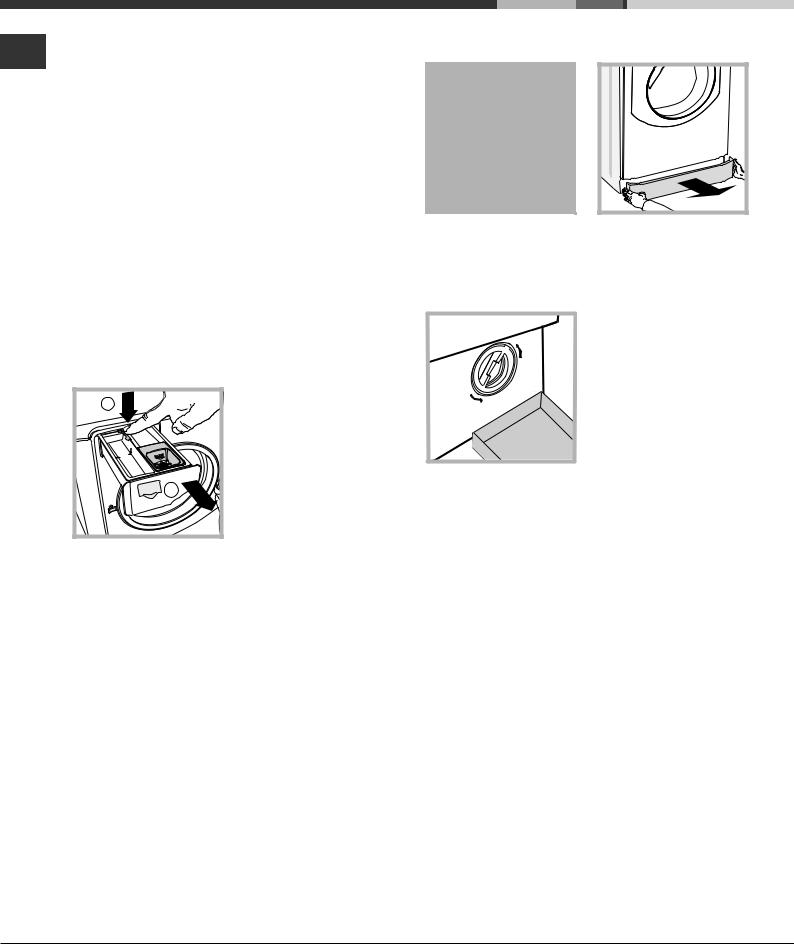
Mantenimiento y cuidados
ES |
Interrumpir el agua y la corriente |
|
eléctrica |
||
|
•Cierre el grifo de agua después de cada lavado. De este modo se limita el desgaste de la instalación hidráulica de la máquina y se elimina el peligro de pérdidas.
•Desenchufe la máquina cuando la debe limpiar y durante los trabajos de mantenimiento.
Limpiar la máquina
La parte externa y las partes de goma se pueden limpiar con un paño empapado en agua tibia y jabón. No use solventes ni productos abrasivos.
Limpiar el contenedor de detergentes
1 |
Para extraer el |
|
contenedor, presione la |
||
|
||
1 |
palanca (1) y tire hacia |
|
afuera (2) (ver la figura). |
||
2 |
Lávelo debajo del agua |
|
2 |
corriente, esta limpieza |
|
se debe realizar |
||
|
frecuentemente. |
Cuidar el cesto
•Deje siempre semicerrada la puerta para evitar que se formen malos olores.
Limpiar la bomba
La máquina posee una bomba autolimpiante que no necesita mantenimiento. Pero puede suceder que objetos pequeños (monedas, botones) caigan en la precámara que protege la bomba, situada en la parte inferior de la misma.
! Verifique que el ciclo de lavado haya terminado y desenchufe la máquina.
Para acceder a la precámara:
1. quite el panel de cobertura delantero de la máquina presionando hacia el centro, luego empuje hacia abajo desde ambos costados y extráigalo (ver las figuras).
2. coloque un recipiente para recoger el agua que se verterá (aproximadamente 1,5 lt.) (ver la figura);
3. desenrosque la tapa girándola en sentido antihorario (ver la figura);
4.limpie con cuidado el interior;
5.vuelva a enroscar la tapa;
6.vuelva a montar el panel verificando, antes de empujarlo hacia la máquina, que los ganchos se hayan introducido en las correspondientes ranuras.
Controlar el tubo de alimentación de agua
Controle el tubo de alimentación al menos una vez al año. Si presenta grietas o rajaduras debe ser sustituido: durante los lavados, las fuertes presiones podrían provocar roturas imprevistas.
28
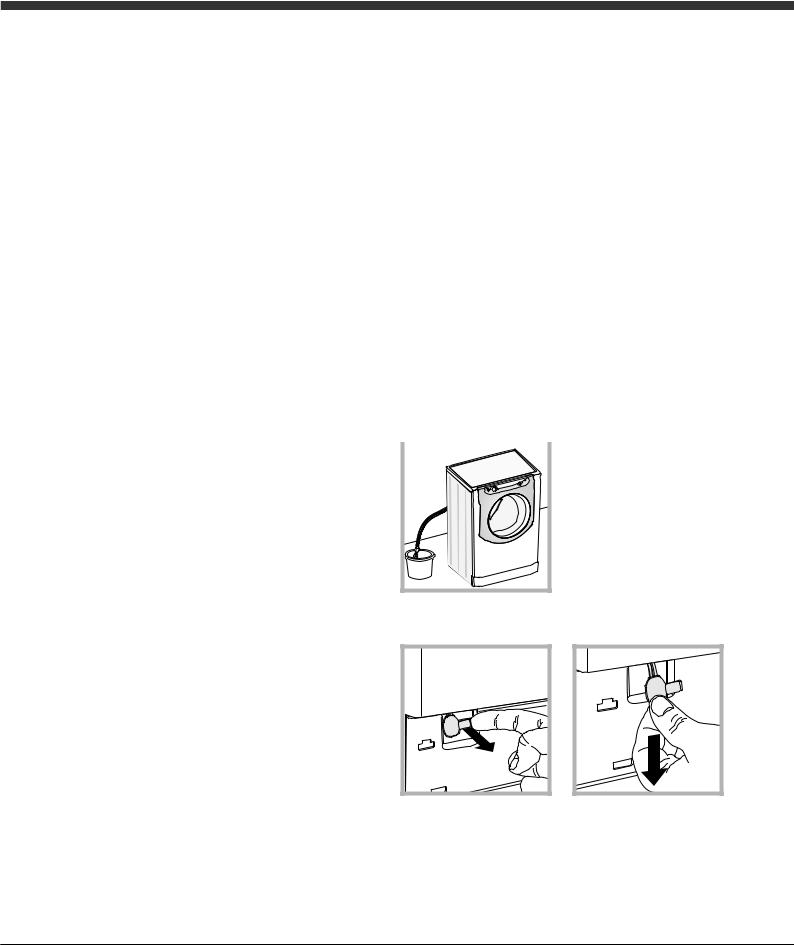
Precauciones y consejos
! La máquina fue proyectada y fabricada en conformidad con las normas internacionales de seguridad. Estas advertencias se suministran por razones de seguridad y deben ser leídas atentamente.
Seguridad general
•Este aparato ha sido fabricado para un uso de tipo doméstico exclusivamente.
•El aparato no debe ser empleado por personas (niños incluidos) con capacidades físicas, sensoriales o mentales reducidas y con experiencias y conocimientos insuficientes, a menos que dicho uso no se realice bajo la supervisión o las instrucciones de una persona responsable de su seguridad.
Los niños deben ser vigilados para asegurarse que no jueguen con el aparato.
-No secar prendas no lavadas.
-Las prendas sucias con sustancias como aceite
de cocina acetona, alcohol, gasolina, kerosén, quitamanchas, trementina, cera o sustancias para quitarlas, deben lavarse con agua caliente con una cantidad mayor de detergente antes de secarlas en la secadora.
-Objetos como la goma expandida (látex), las gorras de ducha, los materiales textiles impermeables, los artículos con un lado de goma y las prendas o cojines que tienen partes de látex no deben secarse en la secadora.
-Suavizantes o productos similares deben emplearse de acuerdo con las instrucciones del fabricante.
-La parte final de un ciclo de la secadora se realiza
sin calor (ciclo de enfriamiento) para garantizar que los artículos no se dañen.
ATENCIÓN: Nunca detener una secadora antes que finalice el programa de secado. En este caso, sacar con rapidez todas las prendas y colgarlas para enfriarlas con celeridad.
•No toque la máquina con los pies desnudos ni con las manos o los pies mojados o húmedos.
•No desenchufe la máquina tirando el cable, sino tomando el enchufe.
•No toque el agua de descarga porque puede alcanzar temperaturas elevadas.
•Nunca fuerce la puerta: podría dañarse el mecanismo de seguridad que la protege de aperturas accidentales.
•En caso de avería, no acceda nunca a los mecanismos internos para intentar una reparación.
•Controle siempre que los niños no se acerquen a la máquina cuando está en funcionamiento.
•Si debe ser trasladada, deberán intervenir dos o más personas, procediendo con el máximo cuidado. La máquina no debe ser desplazada nunca por una sola persona ya que es muy pesada.
•Antes de introducir la ropa controle que el cesto esté vacío.
•Durante el secado la puerta tiende a calentarse.
•No seque ropa lavada con solventes inflamables (por ej. tricloroetileno).
• No seque gomaespuma o elastómeros análogos. |
|
|
ES |
||
• Verifique que, durante las fases de secado, el grifo de |
||
|
||
agua esté abierto. |
|
|
|
Eliminación
•Eliminación del material de embalaje: respete las normas locales, de ese modo, los embalajes podrán volver a ser utilizados.
•La norma Europea 2002/96/CE sobre la eliminación de aparatos eléctricos y electrónicos, indica que los electrodomésticos no deben ser eliminados de la misma manera que los desechos sólidos urbanos. Los aparatos en desuso se deben recoger separadamente para optimizar el porcentaje de recuperación y reciclaje de los materiales que los componen e impedir potenciales daños para la salud y el medio ambiente. El símbolo de la papelera tachada se encuentra en todos
los productos para recordar la obligación de recolección separada. Para mayor información sobre la correcta eliminación de los electrodomésticos, los poseedores de los mismos podrán dirigirse al servicio público responsable o a los revendedores.
Apertura manual de la puerta
Si falta la energía eléctrica es posible abrir la puerta para descargar la ropa del siguiente modo:  1. desenchufe la máquina.
1. desenchufe la máquina.
2. verifique que el nivel de
agua en el interior de la
máquina sea inferior al hueco
de la puerta; si no es así,
extraiga el agua en exceso utilizando el tubo de descarga y recogiéndola en un balde como se indica en la figura.
3. quite el panel de cobertura delantero de la lavadora (ver la página siguiente).
4.utilizando la lengüeta indicada en la figura, tire hacia fuera hasta liberar la varilla de plástico del retén; tire posteriormente hacia abajo hasta sentir un breve sonido que indica que la puerta está desbloqueada.
5.abra la puerta; si todavía no es posible, repita la operación.
6.vuelva a montar el panel verificando, antes de empujarlo hacia la máquina, que los ganchos se hayan introducido en las correspondientes ranuras.
29
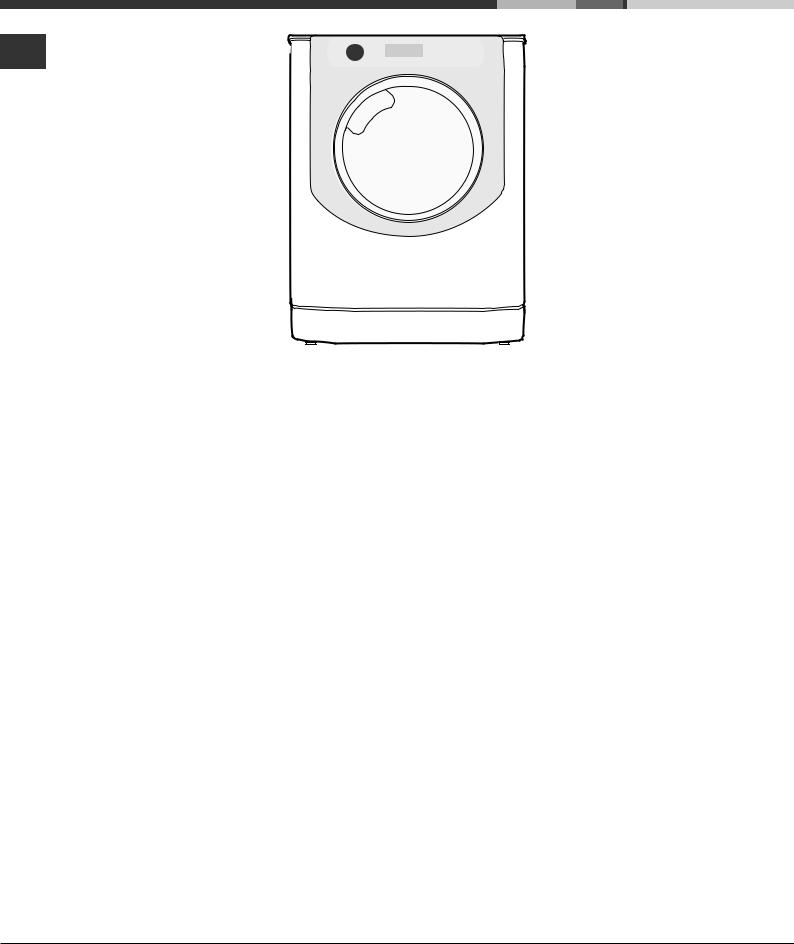
Descripción de la máquina
ES |
|
PANEL DE |
|
|
|
|
PUERTA |
CONTROL |
|
|
MANIJA DE
LA PUERTA
ZÓCALO
PATAS REGULABLES
PUERTA |
Para abrir la puerta utilice siempre la manija correspondiente (ver la figura).
CONTENEDOR DE DETERGENTE
El contenedor de detergentes
se encuentra en el interior de
 la máquina y se accede a él abriendo la puerta.
la máquina y se accede a él abriendo la puerta.
Para la dosificación de detergente, ver el capítulo
“Detergentes y ropa”.
|
A |
|
1. cubeta para el prelavado: |
|
3 |
utilice detergente en polvo. |
|
|
|
||
|
|
! Antes de verter el |
|
|
|
|
|
|
|
1 |
detergente, verifique que |
B |
|
2 |
no esté colocada la cubeta |
|
adicional 3. |
||
|
|
|
2. cubeta para el lavado: Si se |
|
|
|
utiliza detergente líquido, se |
|
|
|
aconseja colocar el tabique |
|
|
|
divisorio A suministrado con |
|
|
|
la máquina, para una correcta |
dosificación. Cuando utilice detergente en polvo, vuelva a colocar el tabique divisorio en la cavidad B.
3. cubeta adicional: Blanqueador
! El uso de la cubeta adicional 3 excluye el prelavado.
 cubeta para aditivos: para suavizante o aditivos líquidos. Se recomienda no superar nunca el nivel máximo indicado por la rejilla y diluir los suavizantes concentrados.
cubeta para aditivos: para suavizante o aditivos líquidos. Se recomienda no superar nunca el nivel máximo indicado por la rejilla y diluir los suavizantes concentrados.
Modalidad de stand by
Esta lavasecadora está en conformidad con las nuevas normativas vinculadas al ahorro energético. Está dotada de un sistema de auto-apagado (stand by) que, en caso de no funcionamiento, se activa pasados aproximadamente 30 minutos. Presionar brevemente el botón ON/OFF  y esperar que la máquina se active.
y esperar que la máquina se active.
Consumo en off-mode: 0,5 W Consumo en Left-on: 0,5 W
30
